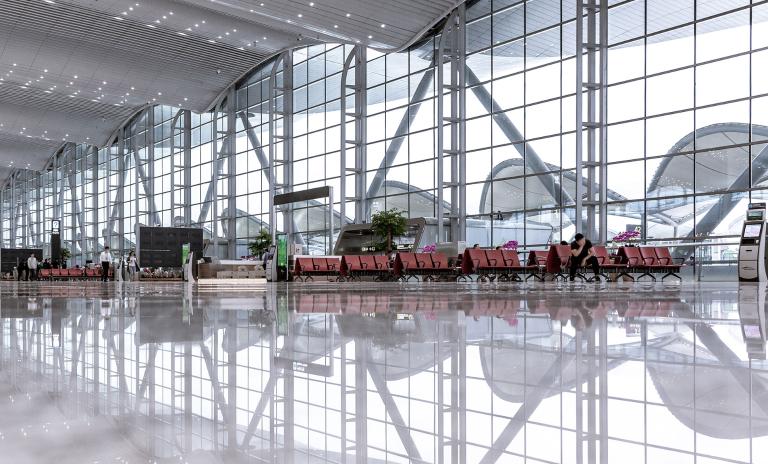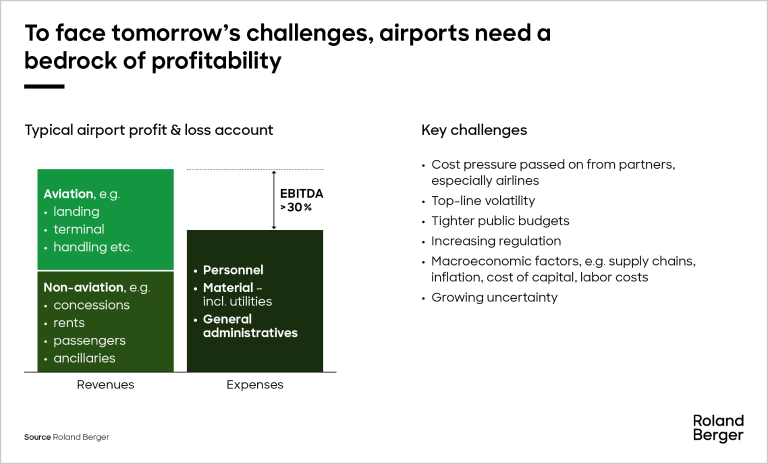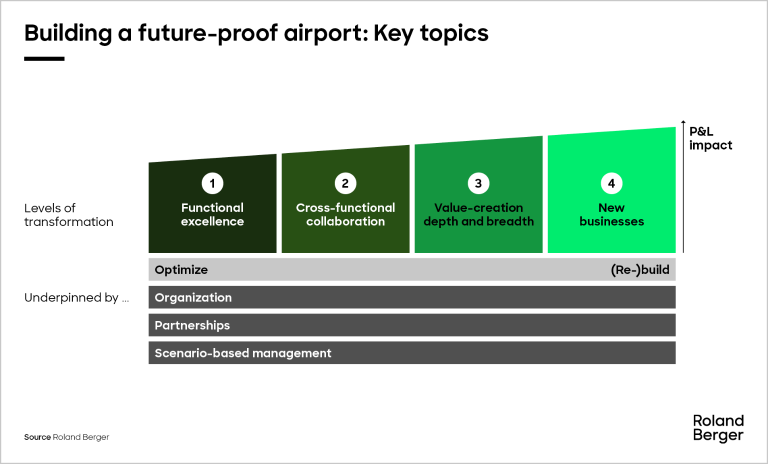Airports influence roughly 15% of all greenhouse gas emissions in the aviation industry. This article gets down to how scope 3 reduction potential can – and must – be realized.


Future-proof airports
In times of growing uncertainty, airports must be ready for whatever lies ahead
Airports are not having an easy time of it. Not only did the COVID-19 pandemic ground their aircraft and practically wipe out their revenues, they are now facing increasingly vocal pressure to decarbonize. At the same time, the shortage of available aviation specialists, demographic change, stricter regulatory requirements, expanding cost pressure and tighter public budgets are limiting their room to maneuver and investors in the industry are less forthcoming than in the past. In these times of straitened circumstances and extreme uncertainty about the future, having a solid bedrock of profitability is crucial. We look at how airports can ensure that they themselves generate enough profit to finance the investments they need to make – and in the process make themselves future-proof.

The environment in aviation is growing tougher by the day, the challenges airports face more complex than ever. On the one hand, there is the increasingly urgent task of decarbonizing and becoming "green airports"; on the other, there are new quality, safety and operational regulations to be met, increasing the burden on airports and their day-to-day activities. In addition, airports are more and more expected to live up to their role as regional mobility hubs, lynchpins in local economic development. Pressure, it seems, is building on all sides – and stakeholders are demanding that airports step up to the table.
But that is only half the story. As the pressure on airports expands, so their room to maneuver shrinks. The current lack of specialists in aviation and ongoing demographic change is making it harder to fill essential positions in their organizations. Cost pressure is expanding as airlines and other partners attempt to pass on their own spiraling costs, while public budgets are becoming tighter. Inevitably, this leaves airports with fewer resources to meet the increasing demands that they face.
Perhaps most challenging of all, however, is the fact that airports are operating in an increasingly uncertain environment. After decades of being able to rely on passenger and freight volumes rising year on year, the COVID-19 pandemic suddenly pulled the rug from under their feet. Macroeconomic developments, such as inflation and growing capital costs, mean that the financial basis on which airports operate and do their planning is not as secure as it was in the past. And owners, stakeholders and investors in the global aviation industry are proving less forthcoming than in the past when it comes to financing new investments.
"Acting within a holistic framework and keeping an eye on various possible futures ensures that all action areas mesh up and can be attuned to changes."
A conundrum
The pressures on airports and the increasing challenges they face create something of a conundrum for airport operators. On the one hand, they need to be adaptable; but at the same time, they must take a long-term view and hammer out an expert investment plan that can cope with future eventualities. They are thus pulled in two contradictory directions, having to plan for a future that they cannot foresee while remaining sufficiently flexible to deal with challenges that they cannot avoid.
The answer, we believe, lies in building a solid bedrock of profitability for airports. This enables them to finance the investments they need to make out of the money they earn themselves. As the environment grows more and more uncertain, airports must learn to be less and less dependent on external budgets. This is the only way they can deliver reliably on what is expected of them.
Make your airport future-proof
To master this challenge, two elements are critical. First, airports must understand which topics to address. This calls for an all-embracing perspective, the ability to avoid getting lost in the detail, and the capacity to set clear priorities. Second, those involved in running airport operations must take the right approach to dealing with uncertainty, investigating different scenarios as we describe below. Critically, topics must be addressed in the right way – the majority of transformation efforts and projects in aviation are currently unsuccessful, despite the high level of knowledge and expertise available within airport organizations. And whatever specific actions the airport decides to take, it should mobilize, embolden and enable the organization to act on a continuous basis, not stopping and starting depending on time or other pressures.
The figure above illustrates our approach to building a future-proof airport. There are four levels of transformation: functional excellence, cross-functional collaboration, value creation and breadth, and new businesses. The further you move to the right in the illustration, the more you move from optimizing the organization to building or rebuilding it – and the greater the impact on the profit and loss account:
The four levels of transformation for airports are underpinned by three further elements:
Our consulting services for the aviation industry
Want to find out more about how you can make your airport fit for the future? Roland Berger is a leading full-service provider of advisory services and airport consulting to clients in the aviation industry. Drawing on extensive experience in airport operations and many real-life case studies, we advise clients on their landside and airside operations, facilities, planning, solutions and strategies. Contact us for a quick review, so we can together reflect on how best you can tackle whatever challenges the future may hold.


_person_144.png?v=770441)















_person_144.png?v=770441)
